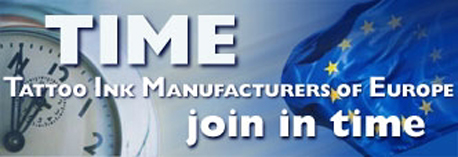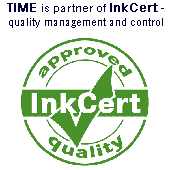About TIME
How TIME came into existence
In May 2003 a big conference of the European Commission took place in Ispra (Italy). Representatives of numerous European countries participated in this conference. Many aspects of the subjects tattoos, permanent make-up and piercing were presented and discussed.
These and other subjects were of importance:
- chemicals, that are used in tattoos and permanent make-up
- allergical reactions after being tattooed
- risks after a laser treatment of tattoos
One of the focus points was the subject colours and safety of colours.
In the same year several tattoo ink manufacturers, who already participated in the conference of Ispra, found TIME (Tattoo Ink Manufacturers of Europe).
TIME – Who we are and what we want
TIME is an association exclusive for ink manufacturers with the purpose to secure and promote the cooperation of the European tattoo ink manufacturers. We want to guarantee an usual exchange of experience and emphasise all of the whole interests of the tattoo ink manufacturer's questions. Thereby we represent the interests of the manufacturers between the public authority and other instances of Europe as well as the member states of the European Union particularly.
Our aims are on the one hand good and safe tattoo inks and on the other hand inks that are hygienic harmless.
At the same time we are against regulations, that don't lead to a improvement of the consumer protection.
To achieve these aims, we work together with the following institutions:
- European Commission,
- European Council,
- National governments and
- Several research groups.
A handling with political especially party political questions doesn't belong to our competence. We are political independend.
We do not interfere with matters of tattooists and we also do not deal with general questions of the subjects tattoo, permanent make-up and piercing. Tattooists, piercer and their associations do that on their own.
Ink manufacturers for tattoos and pigmentation colours can become members of TIME. The member must maintain its own manufacturing plant therefor. The registration for the admission has to be sent to TIME.
Current problems
The current situation for tattoo inks is the following:
- up to 5 % of the in studios used tattoo inks contain carcinogenic aromatic amines.
- up to 30 % of the in studios used tattoo inks contain germs, that are classified as hygienic alarming by authorities. Those germs can lead to death in extreme case.
Many manufacturers and users often don't know, that even killed micro organism and other pyrogenics (substances that are inflammable and cause high temperature) are hygienic harmful and lead to infections and inflammation. Therefor it is not enough to sterilise germinitive burdened colours. Moreover the raw materials must be of highest quality and should be pure within purchasing. The production process has to be as clean as possible. The used colours should be microbiological stable. That means a prevention of germs that are about to spawn.
We want to reduce the number of germs and carcinogenic aromatic amines to zero. Furthermore it is very important for us to produce colours which are free of pyrogenics. We believe that the whole branch benefits from good and safe colours.
We campaign for so-called positive-lists, which regulate the use of pigments (those, which are not carcinogenic) and preservatives (those, which don't cause allergies) in tattoo inks. Thus only those substances which are not hygienic harmful, will be listed.
Resolution
Once back again to the conference in Ispra, Italy:
Not only TIME was found but also a resolution was resolved by the European Council. This resolution defines minimum requirements to tattoo inks. These haven't to be hygienic harmful at least. Moreover the resolution claims the member states to oblige the producers of tattoo inks to carry out a risk evaluation. The results of this evaluation have to be presented or have to be held in ready to the particular authorities before the introduction of the products.
The following and other requirements have been proposed:
- there is no difference between tattoo and permanent make-up
- only those pigments will be allowed, which fullfill the most strict pureness
- tattoo inks have to be sterile (in the sense of germ free), also until the usage
- no aromatic amines must be used
- no preservatives must be used
- only „single-use-units“ should be allowed
- substances, which have the following characteristics, are prohibited:
- carcinogenic
- mutagenic
- reprotoxic - all substances of content have to be declared fully
- the minimal date of durability must be printed on packaging
- the conditions of use and warnings ought to be added on the packaging
- a lot number has to enable a tracking
- a negative-list prohibits the use of many pigments, which are unsuitable for tattoos
Functions and legal meaning of the resolution:
The resolution is a recommendation to the member states to enact and realise regulations. At the same time it is not a duty. The resolution states the best available technolgy, whereas every company is obliged by civil law to have the best available technology. Everbody, who doesn't produce according to that technology, acts grossly negligent and is liable to the full extent for all damages caused by colours.
Foresight
We believe that safe tattoo inks allow that more people get tattooed. Everybody profits from the amelioration of the quality of tattoo inks.
Who profits in detail:
- consumer: they stay healthy and many years after getting tattooed no negative reactions are expected. If a laser treatment is needed, you can be asured, that no carcinogenic aromatic amines are built during that process.
- tattooist: they get more customers.
- reputable producer: will sell more products and can finance new developments
We campaign for a situation, in which no longer carcinogenic and micro biological unstable tattoo inks are offered on the market in the next 5 years.
Our long-term objective is that in 10 years all colours that are on the marked will be hundred per cent bio-compatible.
Statistics
Online since July 2006
News
06.11.2009
Plenetary Assembly
Siegburg, Germany

